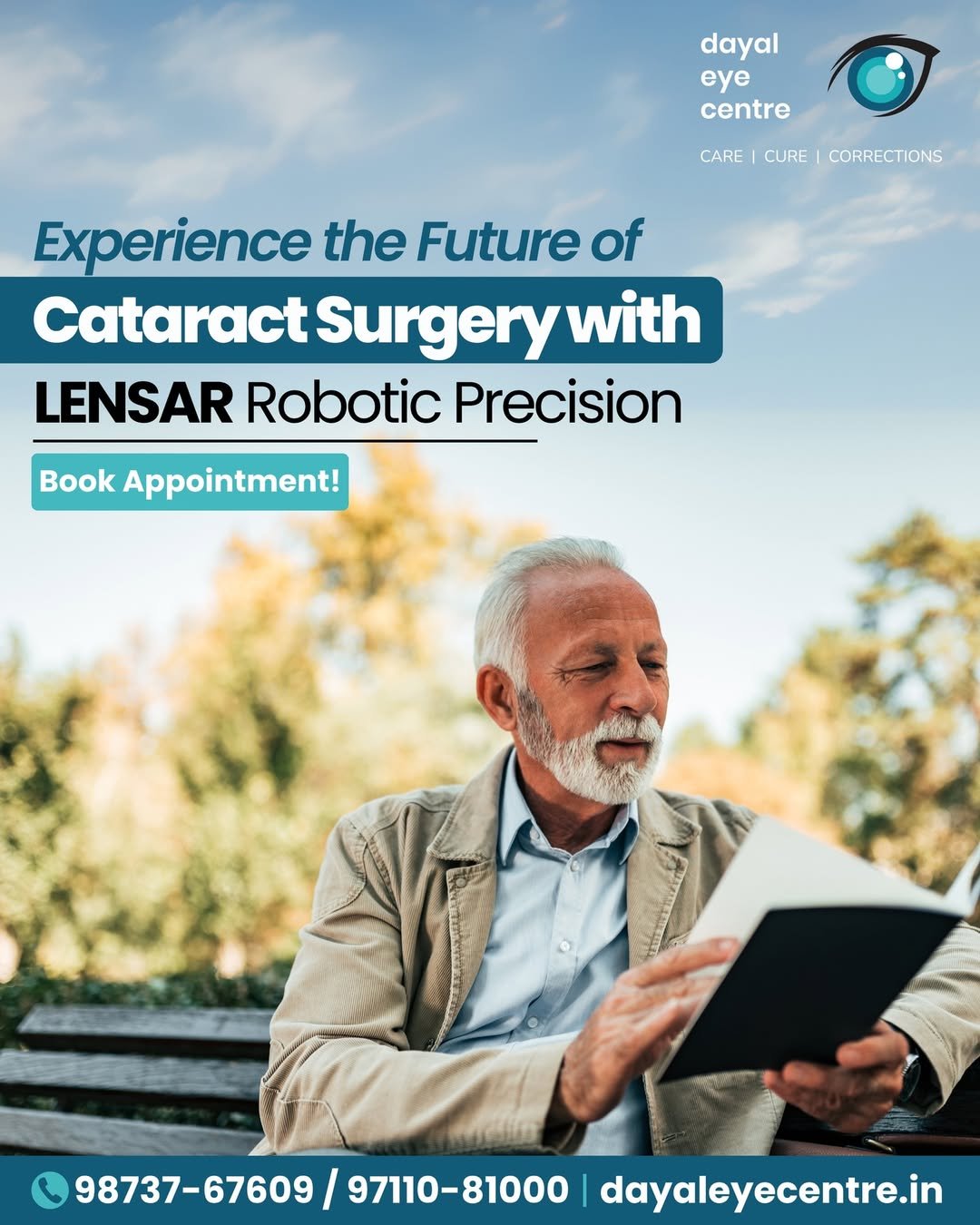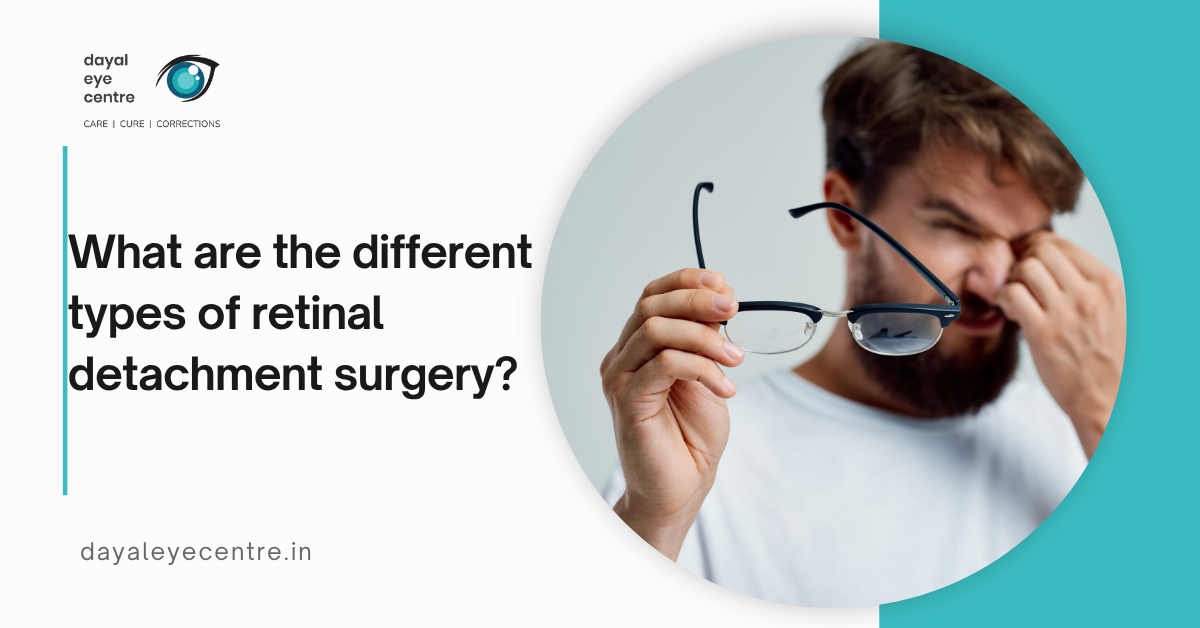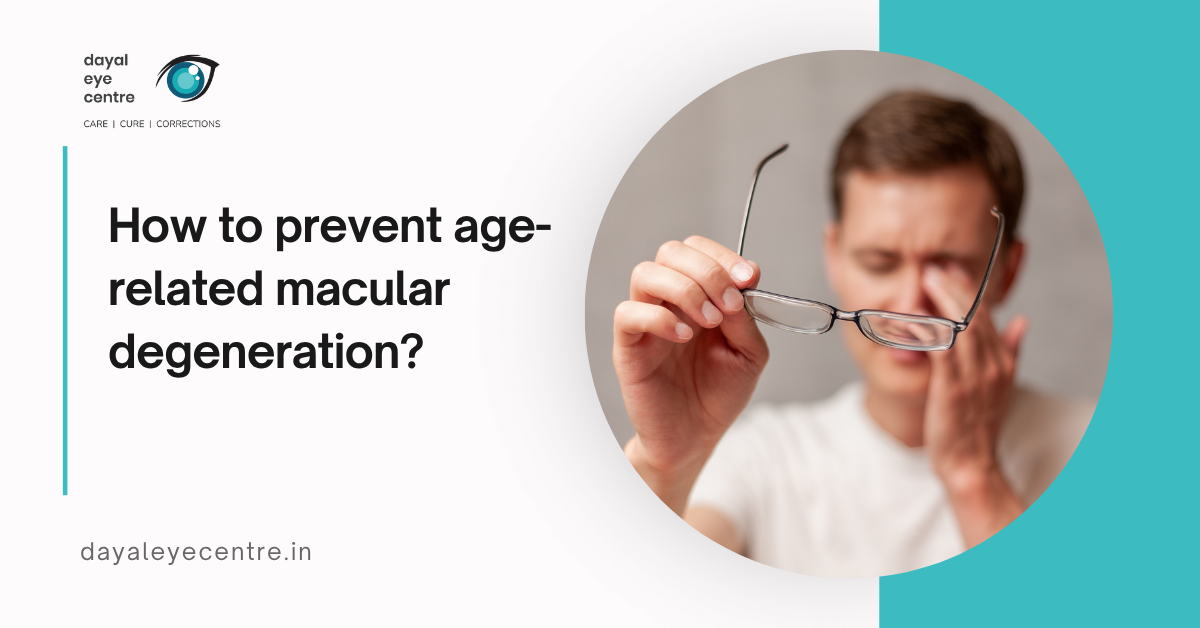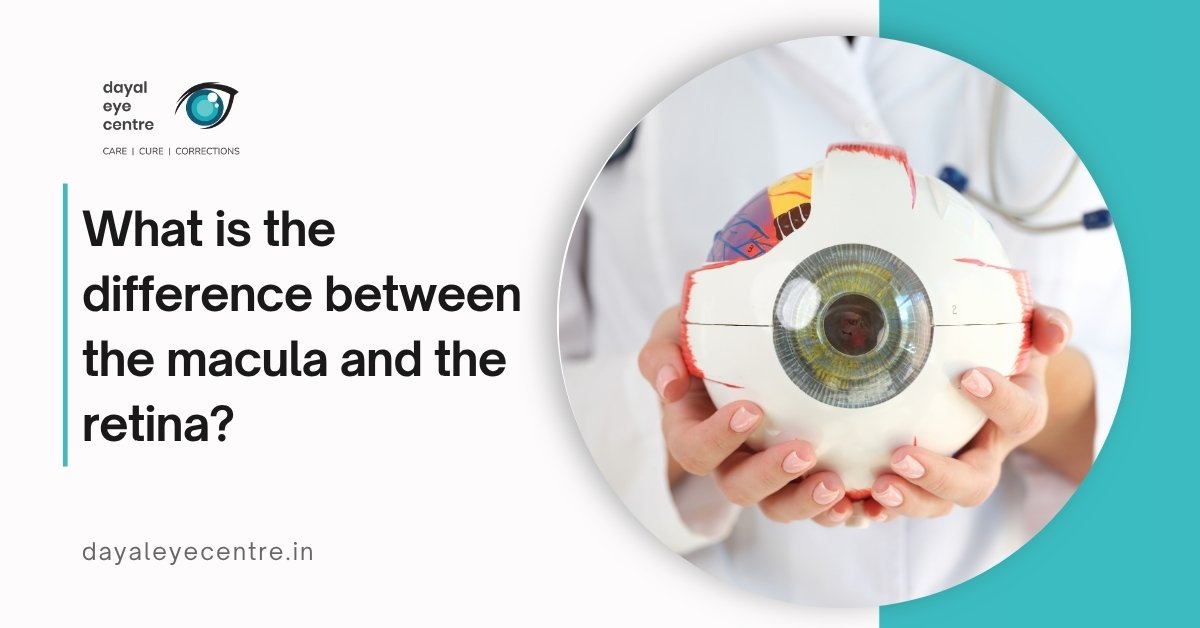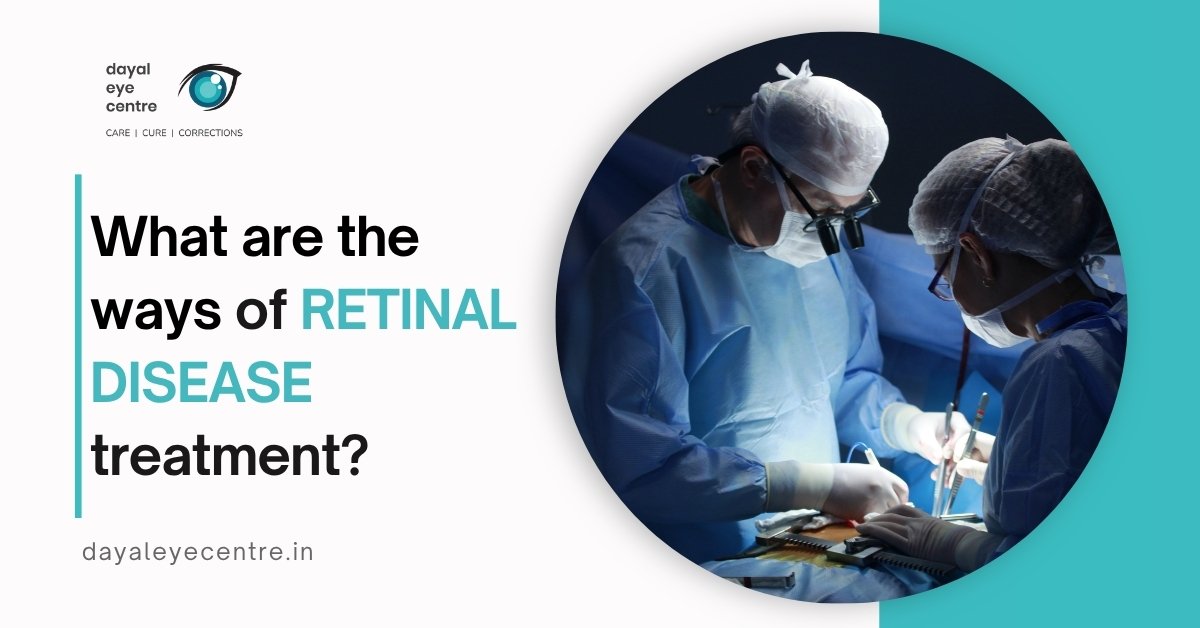The macula, a tiny yet powerful part of your retina, breaks down as you age, causing age-related macular degeneration (AMD). Your vision’s health depends on understanding how this disease affects your eyes. Let’s look at what happens when AMD develops.
Dry vs Wet AMD: Key Differences
AMD exists in two distinct forms that affect your vision differently. Dry AMD makes up about 80-90% of all cases. Tiny yellow protein deposits called drusen build up under the macula and cause it to thin and dry out. Vision loss from dry AMD happens gradually and moves through early, intermediate, and late stages over several years.
Wet AMD affects just 10-15% of patients but creates more serious vision issues. This type occurs when abnormal blood vessels grow under the retina near the macula and leak blood and fluid. The term “wet” describes this leakage. Though less frequent, wet AMD results in faster vision loss and ranks as the leading cause of severe vision deterioration.
About 10-20% of untreated dry AMD cases turn into the wet form.
How Aging Affects the Macula
Your eyes undergo several changes with age that can lead to AMD:
- The retinal pigment epithelium (RPE) cells that support photoreceptors change substantially. These cells build up metabolic debris from unprocessed photoreceptor fragments.
- Bruch’s membrane under the retina becomes thicker from lipid buildup, which limits fluid movement between the RPE and choroid.
- RPE cells accumulate lipofuscin (waste material) that changes metabolism and creates drusen beneath the RPE.
- Oxidative stress plays a vital role in AMD development. Exposure to light and high oxygen tension creates reactive oxygen species that harm cellular mitochondria.
- This ongoing damage can trigger inflammation and produce growth factors like vascular endothelial growth factor (VEGF), which might stimulate abnormal blood vessel growth in wet AMD.
RPE cells also show increased shape changes, reduced concentration in the posterior pole, and less melanin content as age advances.
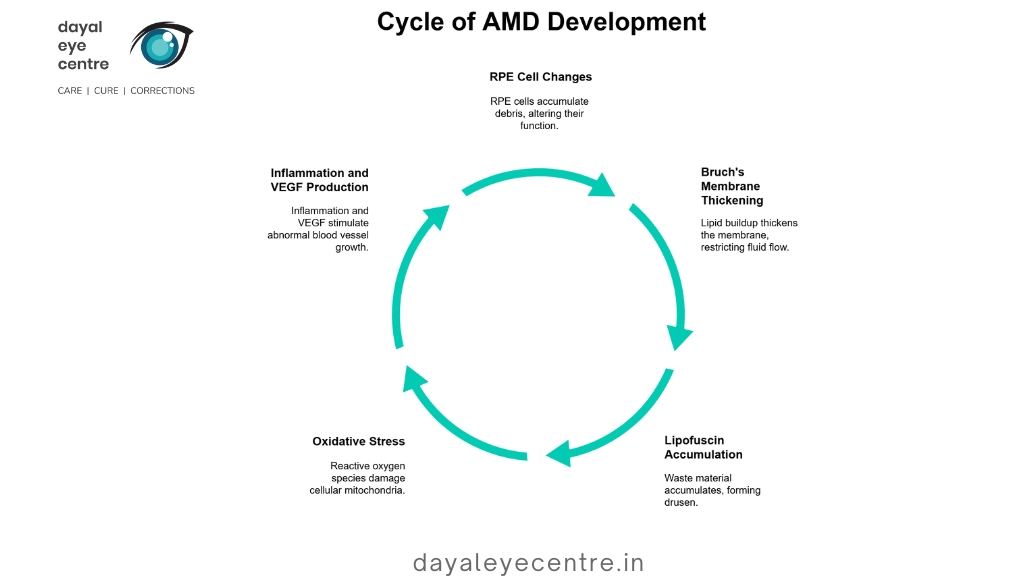
Why Central Vision Is Most Affected
The macula contains the highest concentration of cone photoreceptors that handle high-resolution visual acuity. This explains why AMD impacts your central vision while leaving peripheral vision untouched.
AMD typically shows these symptoms:
- Blurry or dark spots in central vision
- Straight lines that look wavy or crooked (especially in wet AMD)
- Problems seeing fine details straight ahead
- Colors that seem less vibrant
- Difficulty seeing in dim light
- Intact peripheral (side) vision
People with AMD can still use their peripheral vision but find it hard to read, recognize faces, drive, or do detailed work.
Symptoms progress differently based on AMD type. Dry AMD brings gradual changes, while wet AMD can cause sudden vision changes and more severe vision loss. Regular eye exams help catch macular degeneration early since symptoms might not appear until the condition has progressed significantly.
Know the Risk Factors You Can Control
Your risk of AMD increases with age, but you can control several factors that affect your chances of developing this condition. Learning about these modifiable risk factors helps you take active steps to protect your vision.
Smoking and Its Impact on Eye Health
Smoking is the most dangerous controllable risk factor for age-related macular degeneration. The data is clear – current smokers are 2-4 times more likely to develop AMD than non-smokers. The risk stays high for former smokers up to 20 years after they quit.
Major studies worldwide support this link:
- The Beaver Dam Eye Study found higher rates of neovascular AMD in current smokers whatever their gender
- The Rotterdam Study showed smoking’s link to AMD lasted decades after people quit
- The Blue Mountains Eye Study revealed a “highly significant association” between current smoking and geographic atrophy
The EUREYE Study found that 27% of AMD cases came directly from smoking. Some researchers suggest cigarette packs should warn about blindness risk among other health dangers.
Second-hand smoke raises the risk too – non-smokers who live with smokers are almost twice as likely to develop AMD. Quitting smoking is one of the best ways to protect your eyes.
Family History and Genetic Risk
You can’t change your genes, but knowing your genetic risk helps you make better lifestyle choices and monitor your eye health. Having a first-degree relative with AMD makes you three times more likely to develop it.
Research shows genes play a part in about three-quarters of AMD cases. Studies of families show that relatives of AMD patients face higher risks (2.4 to 19.8 times) than people without family history.
Scientists found the strongest genetic evidence in major disease susceptibility alleles on chromosomes 1q32 and 10q26. Just one risk allele of CFH can make AMD start 10 years earlier, whatever your smoking status.
People with AMD in their family should watch other risk factors carefully. Regular eye exams become vital to catch macular degeneration symptoms early.
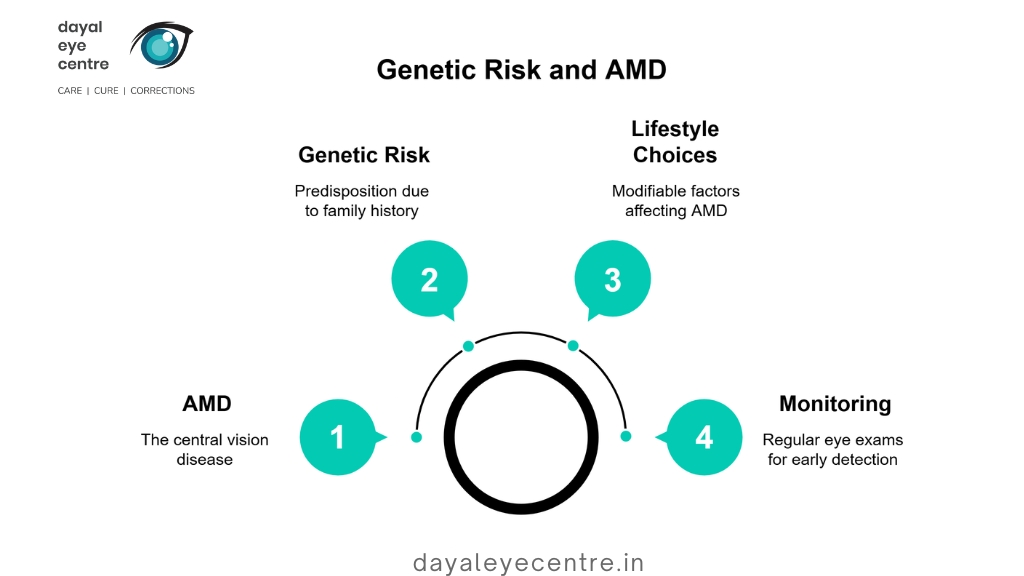
High Blood Pressure and Obesity
Your heart health directly affects your vision. High blood pressure can damage the small blood vessels in your eyes and lead to AMD. Studies show that neovascular AMD links to diastolic blood pressure above 95 mm Hg (4.4 times higher risk).
Your weight matters too. People with BMI over 30 are 2.5 times more likely to develop AMD than those with lower BMI. Belly fat seems especially risky – a large study showed it independently raised men’s risk of early AMD by 13% and late AMD by 75%.
The good news? Losing weight helps protect your eyes. A 3% drop in waist-to-hip ratio leads to 29% lower AMD risk. Obese people benefit even more – the same reduction in waist-to-hip ratio cuts their AMD risk by 59%.
Other factors you can control:
- Protect yourself from sun exposure (men need this most)
- Get enough sleep (6-8 hours works best)
- Keep your cholesterol in check
Taking care of these risk factors can lower my chances of early macular degeneration symptoms a lot, even with genetic risks.
Adopt a Diet That Supports Eye Health
Good nutrition protects your eyes from macular degeneration naturally. Studies show specific nutrients support macular health and can slow down or prevent age-related macular degeneration.
Foods Rich in Lutein and Zeaxanthin
Your macula stores carotenoid antioxidants called lutein and zeaxanthin. These pigments work like natural sunglasses to protect your retina from harmful blue light. They also neutralize cell-damaging free radicals. You need to get these nutrients from food since your body can’t make them.
The best sources are:
- Dark leafy greens – spinach, kale, collard greens, turnip greens, and romaine lettuce
- Colorful vegetables – red peppers, broccoli, corn, and peas
- Other sources – egg yolks, pistachios, and tangerines
Raw kale gives you about 11mg of lutein per cup, and cooked spinach provides up to 16mg. Egg yolks have less lutein but your body absorbs it better because of their fat content. You can boost absorption by adding healthy fats like olive oil to these foods.
Benefits of Omega-3 Fatty Acids
Your retina needs omega-3 fatty acids, especially DHA and EPA. DHA helps your photoreceptor cells work better since it’s a major part of retinal tissue. These fats also reduce inflammation that can lead to AMD.
You’ll find these healthy fats in cold-water fish like:
- Wild salmon
- Mackerel
- Bluefin tuna
- Herring
The largest longitudinal study found people who ate lots of omega-3s had 38% less risk of late AMD. Eating fish twice a week reduced early AMD risk by 24% and late AMD risk by 33%.
The Mediterranean Diet and AMD Prevention
The Mediterranean diet takes a complete approach to protecting your eye health. This diet focuses on vegetables, fruits, whole grains, legumes, fish, olive oil, and less red meat.
Research backs this up well. Reviews show this diet can lower AMD risk by 23% and slow its progression by 34%. People who followed the diet closely had 26% less chance of developing advanced AMD.
This diet works so well because its nutrients work together better than they do alone. You get plenty of lutein, zeaxanthin, omega-3s, fiber, and antioxidants that fight oxidative stress and inflammation—major factors in AMD. The diet also helps control obesity and metabolic syndrome, which increase your AMD risk.
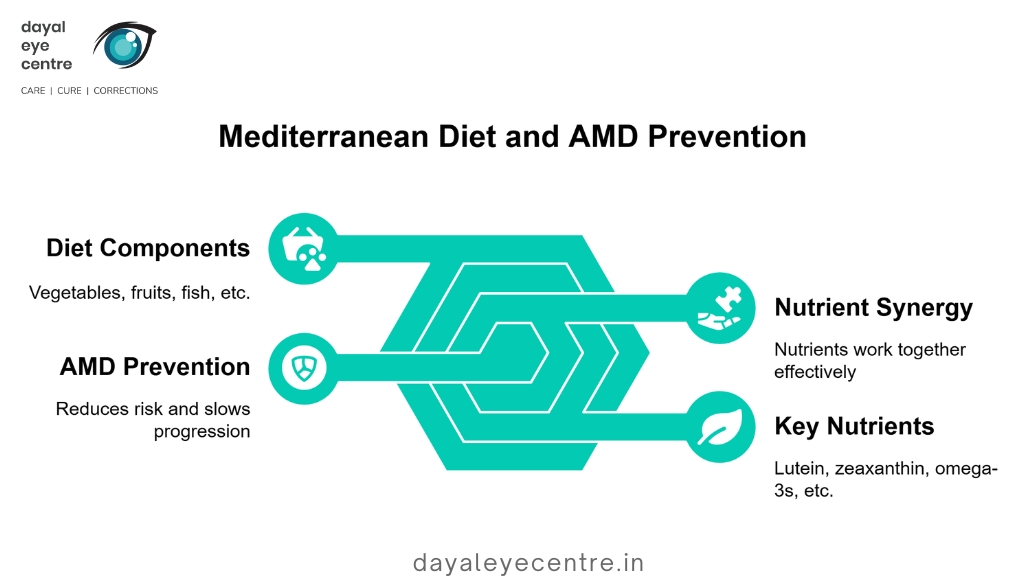
Use Supplements Backed by Research
Supplements work alongside diet to protect against advanced age-related macular degeneration. Research shows specific supplement combinations can slow down the disease in some people.
What AREDS and AREDS2 Recommend
The Age-Related Eye Disease Studies (AREDS and AREDS2) are groundbreaking clinical trials that proved which supplement combinations work for AMD. The first AREDS formula cut the risk of advanced AMD progression by 25% over five years. Here’s what the improved AREDS2 formula contains:
- 500 mg vitamin C
- 400 IU vitamin E
- 80 mg zinc
- 2 mg copper
- 10 mg lutein
- 2 mg zeaxanthin
The AREDS2 team switched beta-carotene with lutein and zeaxanthin after studies showed these carotenoids worked better. Later research confirmed this new mix lowered AMD progression risk by about 26%.
Who Should Think Over Eye Vitamins
Research shows AREDS2 supplements help specific groups – patients with intermediate AMD in one or both eyes, or those who have late AMD in one eye. These supplements don’t stop AMD from starting in healthy people. About 90% of doctors prescribe supplements based on these guidelines.
Standard multivitamins can’t replace AREDS2 supplements because they don’t have the exact nutrient mix and amounts that clinical trials proved effective. People with early AMD or family history need regular eye checkups, though we don’t know if supplements help these groups.
Cautions for Smokers Using Supplements
Smokers and ex-smokers should stay away from the original AREDS formula with beta-carotene. Studies showed that beta-carotene doubles lung cancer risk in current and former smokers. The AREDS2 study found more lung cancer cases in people taking beta-carotene (2%) compared to those who didn’t (0.9%).
Talk to your doctor before starting supplements. AREDS2 formulas have high doses of vitamins and minerals that might affect your medications or digestion. Smokers can safely use the AREDS2 formula with lutein and zeaxanthin – it works just as well without the risks.
Protect Your Eyes from Environmental Damage
Environmental factors play a significant role in speeding up or slowing down age-related macular degeneration progression. You can take control by learning to protect your eyes from these hazards. This represents a vital preventive measure under your control.
Why Sunglasses Matter
Ultraviolet (UV) radiation creates oxidative stress in your eyes’ delicate structures and speeds up the aging process of ocular tissues. Your risk of developing AMD increases with long-term exposure to these invisible rays. So, wearing sunglasses that offer 100% UV protection builds an essential defense against this threat.
Labels that show “100% UV protection” or “UV400” should be your priority when buying sunglasses, as these block both UVA and UVB rays. The best protection comes from wrap-around styles or glasses with large lenses because they block light from entering sideways. UV damage adds up throughout your life—more exposure means higher risk of macular degeneration symptoms.
Blue Light and Screen Exposure
High-energy visible (HEV) blue light goes deeper into the eye than other light types. Both sunlight and digital devices emit this blue light. Notwithstanding that, experts still debate the evidence about blue light from electronic devices.
Harvard Health states blue light from smartphones, tablets, and computers likely won’t harm the retina or increase macular degeneration risk. Other research suggests your overall eye health might suffer from too much screen time through eye strain.
Role of Blue-Light Filtering Lenses
Scientists have found mixed results in blue-light filtering technology research. Some studies show blue-light filtering intraocular lenses (BLF-IOLs) might reduce AMD progression by about 40% over nine years. Other clinical trials found standard lenses work just as well as BLF-IOLs to prevent neovascular AMD.
The Cochrane Review found blue-light filtering spectacle lenses offer minimal benefits for computer-related eye strain in daily use. Here are practical ways to protect your eyes:
- Follow the 20-20-20 rule: every 20 minutes, look at something 20 feet away for 20 seconds
- Keep a humidifier running in dry indoor spaces
- Cut back on screen time, especially before bed
Conclusion`
Take Action Now to Preserve Your Vision
Age-related macular degeneration affects many people, but science shows it’s not inevitable. As we’ve covered, you have multiple ways to protect your central vision from this condition.
Your lifestyle choices serve as the first defense against AMD. Quitting smoking, keeping healthy blood pressure, and managing weight reduce your risk by a lot. On top of that, regular exercise helps your eye health by improving blood flow and fighting inflammation.
What you eat plays a vital role in preventing AMD. Dark leafy greens packed with lutein and zeaxanthin, plus omega-3 fatty acids from fish, protect your eyes. The Mediterranean diet gives you a complete approach to nutrition that cuts AMD risk by up to 41%.
Supplements can help too, but they’re not for everyone. People with intermediate AMD should talk to their eye doctor about AREDS2 formulations. Those without AMD or in early stages might not need these supplements.
Protecting your eyes from harm matters just as much. Good sunglasses that block all UV rays shield your eyes from harmful radiation. While research on digital device blue light shows mixed results, smart screen habits help keep your eyes comfortable.
Regular eye exams give you the best chance to catch problems early. Most people don’t notice early macular degeneration signs because they develop slowly. Yearly complete eye exams let doctors find AMD when treatment works best.
Your genes don’t determine your fate. Even with family history, you can lower your AMD risk through prevention. The best protection comes from combining healthy eating, exercise, eye protection, and regular checkups.
Starting these steps today gives you the best shot at keeping clear, sharp vision throughout life. Your future self will thank you for protecting your sight.
FAQs
Is it possible to prevent age-related macular degeneration (AMD)?
While there's no guaranteed way to prevent AMD, you can significantly reduce your risk through lifestyle changes. These include quitting smoking, maintaining a healthy diet rich in leafy greens and fish, exercising regularly, and protecting your eyes from UV radiation.
What dietary choices can help protect against macular degeneration?
A diet rich in lutein and zeaxanthin (found in dark leafy greens), omega-3 fatty acids (from fish), and adherence to a Mediterranean-style diet have shown promising results in reducing AMD risk. Consuming a variety of colorful fruits and vegetables also provides beneficial antioxidants for eye health.
Are supplements effective in preventing or slowing AMD progression?
For individuals with intermediate AMD, specific supplement formulations like AREDS2 (containing vitamins C and E, zinc, copper, lutein, and zeaxanthin) have been shown to slow disease progression. However, these supplements are not recommended for prevention in those without AMD or with early-stage AMD.
How important are regular eye exams in managing AMD risk?
Regular comprehensive eye exams are crucial for early detection of AMD. Many people miss early symptoms because they develop gradually. Annual check-ups allow doctors to spot AMD in its earliest stages when intervention is most effective, making them a powerful tool in preserving vision.
Can lifestyle changes really make a difference in AMD risk?
Yes, lifestyle modifications can significantly impact AMD risk. Quitting smoking, maintaining healthy blood pressure and weight, exercising regularly, and protecting your eyes from UV radiation are all effective ways to reduce your chances of developing AMD or slowing its progression if you already have early signs.
Author

Dr. Sanjeev Bisla is an expert eye specialist in Gurgaon. With more than two decades of experience, he is the director and chief ophthalmologist of Dayal Eye Centre.
View all posts


